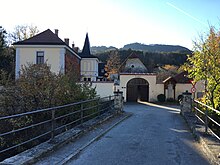Steghof (Scheibbs)
The Steghof is a stately home from the Middle Ages and is located directly on the left bank of the Erlauf north-west of the city center of the municipality of Scheibbs in the Scheibbs district in Lower Austria . The name Steghof refers to the crossing in front of the building, originally a wooden footbridge, which was replaced in 1554 by a stone bridge, the Roman Bridge .
history
In 1336, "Chunrat der Scheuerbech" (Scheuertbach) sold the "Hof am Steg" with the Hofstatt in Vogelsang to the sovereign to donate the Kartause Gaming . As the estate of the monastery, it was given as a fief. In 1358 the farm was owned by the "Chlaechel", in 1361 "Hainreich der Chlaechel" sold the farm, a castle rights loan from the Gaming monastery, his brother Seifriden and other relatives. Rueprecht Laffenthaler appeared here in 1538 and Andre Peugenast in 1554. In the 20th century, the Steghof was owned by the Jenewein family , most recently the Sedlinger family.
investment

The Steghof is located around 550 meters northwest of the parish church of Scheibbs, directly on the left bank of the Erlauf. The property is a bit away from the city center, directly between Erlafstrasse, which runs north and accompanies the river, and the railway line to Kienberg-Gaming . The multi-sided, inhabited and well-kept complex consists of the southern, east-west-facing residential wing and a courtyard connected to the north, which is surrounded by utility wings in the north and west. The two-storey residential wing shows a late historical facade structure, but according to Dehio it should go back to the 17th century. The building has a flat hipped roof ; a two-storey, tower-like portico with a high, pointed hipped roof is in front of the north side of the courtyard . According to Dehio, the farm wing dates from the 18th century. On the street side, a wall with a central arched gate closes the courtyard, the inscription "Steghof 1316" is painted over the gate . Since the entire building is plastered and there is no insight into the wall technology, no further statements can be made about the age of the building.
literature
- Marina Kaltenegger, Thomas Kühtreiber , Gerhard Reichhalter, Patrickschicht, Herwig Weigl: Mostviertel castles. Published by Falko Daim . Vienna 2007, p. 246 f.
- Dehio Niederösterreich, south of the Danube (published by Bundesdenkmalamt), 2 volumes, Horn / Vienna 2003, 2018.
- Herbert Pöchhacker: Castles and mansions in the Scheibbs district from 1000 to 1500. Local history of the Scheibbs district, Volume 5, Scheibbs 1986, p. 272 f.
Individual evidence
- ↑ Search result - Lower Austrian castles online | IMAREAL. Retrieved November 1, 2018 .

